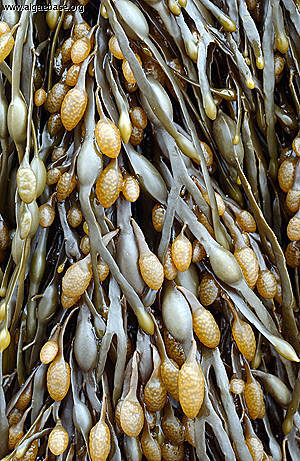Seaweed meal and liquid seaweed extracts
 In Ireland, up to 8,000 dry t of seaweed meal was previously produced from "blackweed" (total drift; mainly wracks and kelps), but this practice has, fortunately, now ceased (Table 3) as this material was very variable in quality. Seaweed meal is now produced exclusively from Ascophyllum nodosum (right). About 16,000 wet t of this wrack are currently cut by hand in Connemara (Co. Galway) and in Co. Donegal. The weed is dried using coal-dust-fired tunnel dryers at two locations to give about 3,000 dry t of seaweed meal, half of which is currently exported to Scotland for alginate production. Ireland has never been an alginate-producing country. Some 1500 dry t are used as a soil conditioner and for the production of liquid seaweed extracts.
In Ireland, up to 8,000 dry t of seaweed meal was previously produced from "blackweed" (total drift; mainly wracks and kelps), but this practice has, fortunately, now ceased (Table 3) as this material was very variable in quality. Seaweed meal is now produced exclusively from Ascophyllum nodosum (right). About 16,000 wet t of this wrack are currently cut by hand in Connemara (Co. Galway) and in Co. Donegal. The weed is dried using coal-dust-fired tunnel dryers at two locations to give about 3,000 dry t of seaweed meal, half of which is currently exported to Scotland for alginate production. Ireland has never been an alginate-producing country. Some 1500 dry t are used as a soil conditioner and for the production of liquid seaweed extracts.
Adding seaweed meals to light soils improves water retention and probably provides scarce nutrients and trace elements. In addition, there may be growth-promoting effects due to natural substances in the seaweeds. Precisely what these are, we are still uncertain, but most of the smart money is on betaines, simple organic compounds present in relatively large amounts in marine algae. While there may be beneficial effects from these substances being leached out of seaweed meals, the practice today is to extract the material from the algae in a liquid form by a variety of methods. Such extracts are referred to as liquid seaweed extracts and are known to have an extraordinary range of effects of crops including: improved yield, better frost resistance, increased ability to withstand fungal, nematode and insect attack, enhanced chlorophyll retention, and so on (Blunden 1991). Some of these effects--particularly yield increases--are often attributed to the nutrients in the extracts but the observed effects could not be due to any of the nutrients or trace elements as the sprays are so dilute at the recommended dosages.
Manufacturers of liquid seaweed extracts in Ireland





